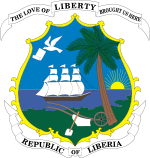Solar Energy and Its Potential in Liberia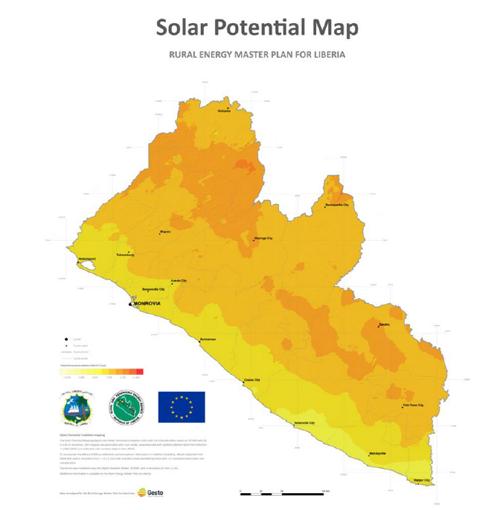
Solar energy is radiant light and heat (photons) from the sun. This energy can be used by plants in the process of photosynthesis. Technologies can also make this energy usable, either directly for heating or with the photovoltaic (PV) effect to produce electricity.
The humid, tropical climate in Liberia shows relatively constant temperatures throughout the year, around the average of 27° C (81° F ), hardly ever outside the range of 20° C (68° F ) to 36° C (97° F ). In Liberia, monthly solar radiation on horizontal surface ranges from about 4 kWh/m2/day during the rainy season in June, July, August to 6 kWh/m2/day during the height of dry season in February and March.
This high and consistent potential for solar energy across the country adds to an average level of 1,712 kWh/m2/year, which could generate 1,400 to 1,500 kWh/kWp. Especially small/medium scale rural electrification in Liberia could be done with solar technology, possibly combined with diesel and batteries to support Low Voltage Transitional mini-grids.
Solar Systems Used in Liberia
A solar system collects solar energy and puts it to use. A solar dryer directly uses the sunlight without storing it. A simple DC system for a solar lamp collects the sunlight with a photovoltaic module or solar panel. This is a semiconductor mostly made of purified silicon. In this panel the light and heat in form of photons from the sun cause electrons to flow. This direct current (DC) can be stored in a battery to power the lamp or phone charger. The Loads of a system are the devices to which the power is delivered, such as a refrigerator, fans, computers, keyboards, calculators, street lamps, traffic lights, cookers, waste compacting bins, vehicles, water heaters, water pumps air conditioning and others.
More complex systems have more components (see below). Different types of photovoltaic modules have been developed. In recent years, solar technologies became more efficient and less expensive. In Liberia, several schools and clinics have solar lighting systems and/or fridges for vaccinations. Also, solar streetlamps are installed in various areas too. In Monrovia, traffic lights are powered by solar energy.
Types of Solar Systems Used in Liberia
|
System |
Description |
Power range |
In Liberia |
|
Pico PV System |
Small rechargeable solar devices such as lanterns, phone charger, radio etc., that are easy to carry around. Its small amorphous panel makes the system easy to charge even if clouds cover the sun. The panel is either on the device or can be easily connected to the device. |
Battery sizes of 1.5, 3, 4.5 & 6 volts DC |
used in rural and urban Liberia |
|
Small Solar Home System (SHS) |
Mainly provides light at night with a mini solar system comprising of several lamps, a battery, cables and switches. The solar panel can be installed by a non-technical person (“PLUG N Play system”) on a sun-exposed rooftop. |
6 to 12-volt dc, Mainly built with Lithium battery |
Used, but not yet very common |
|
Off-grid Home System |
Separate power distribution in separate homes. A set-up mechanism for maintenance security allows monitoring performance and collecting tariff. SHS is a home based system or a PNP which operate on DC mainly with a small power source, while a Mini-grid is slickly bigger and can be operated using DC or AC power by adding an inverter without synchronization. |
12 to 24 v dc depending on its size. |
in rural Liberia at clinics, school and public facilities |
|
Solar Power Mini-grid |
Solar panels on or around a powerhouse with batteries can supply connected households in rural towns or villages with solar electric power. To ensure maintenance, repair, and replacement of batteries (after xxx years, depending on system and care) households are often asked to pay small tariffs and are disconnected if they fail to pay. |
220- 240 AC depending on its capacity |
40 Kilowatts power system in Totota, Bong; five mini-grids planned in Lofa |
|
Solar Stand-alone photovoltaic systems |
Fridges, TV set, fans, street lamps, water pumps. These can also be powered by solar with DC or an AC power conversion with a separate power grid that has been generated from the sun. A standalone has no inter- or hybrid connectivity.
|
This can either be a DC or Ac power connection rating from 12, 24 or 48 vdc power conversion. |
solar fridges in clinics, solar street lamps, e.g., in Monrovia, Barclayville, Zorzor |
|
Stand-alone solar heating products |
This can either be a Solar Dryer or a Solar Cooker that uses the solar energy to generate power by radiation. Power dissipated from this source can be used for drying, cooking or sterilization. |
Radiation from the sun or heat condensation. |
Solar cocoa dryers in several counties, e.g. Bong, Nimba |
The smallest and simplest systems in the range of solar products are portable, handheld lanterns/torches/flashlights that have a small inbuilt or attached solar panel. Some of the lamps allow the charging of mobile phones. Quality can vary and it is important to look for lamps that follow the Lighting Global Minimum Standards (https://www.lightingglobal.org/products/) such as the products below that are sold by solar retailers in Liberia.
-
 Barefoot connect 600
Barefoot connect 600 -
 Barefoot firefly
Barefoot firefly -
 Barefoot Go
Barefoot Go -
 D- Light D20
D- Light D20
-
 D-Light S2
D-Light S2 -
 D-Light S20
D-Light S20 -
 d-light S300
d-light S300 -
 Fosera scandle 200
Fosera scandle 200
-
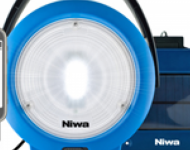 Niwa Multi 100 plus
Niwa Multi 100 plus -
 Niwa Multi 300 XL
Niwa Multi 300 XL
Solar Home systems
In a more complex solar home system, for example, a 600watt peak DC and AC Solar system, more components add to the solar panel, the battery and the load. The charge controller can help to protect the battery from overcharge and over discharge. While, the inverter is used to transform the current to alternating current (AC) to have plug-ins and to power regular electronic appliances. The fuse normally sacrifices itself or cuts apart to stop current from flowing if it becomes overloaded and the circuit breaker automatically switches/interrupts current flow after a fault is detected.
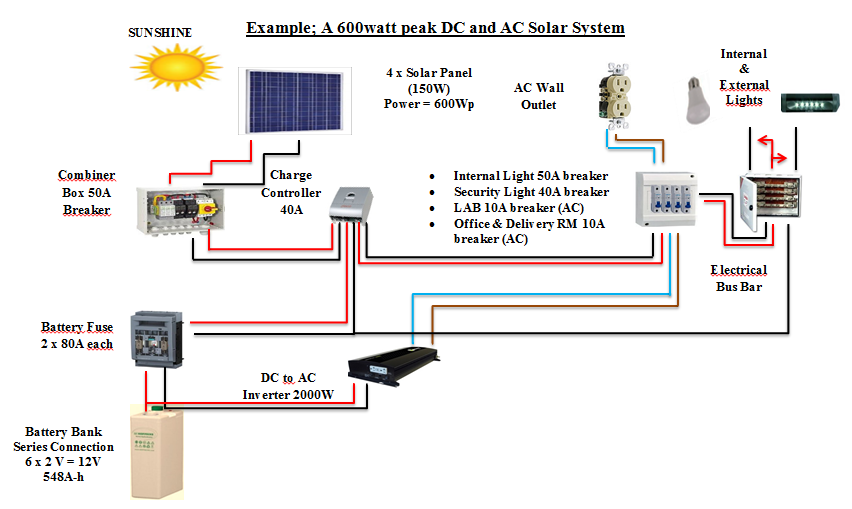
Read more
Various projects promote solar technologies in Liberia.
Detailed description of one solar system installed in 13 health facilities
How photovoltaic cells work: here as text or here as video.
For more information about solar technology, visit Energypedia.
To use solar energy for drying various products, e.g., cocoa, different types of dryers can be used. A Tunnel Dryer converts the solar energy into electric energy that is then used for heating and ventilation. Other dryers use a greenhouse plastic and natural occurring wind or thermic air movements to dry the produce.
The various dryer types differ in their strengths and weaknesses. While all four solar dryer models depicted below have been tested for Liberia, the most commonly used models are the house model and the table model.

